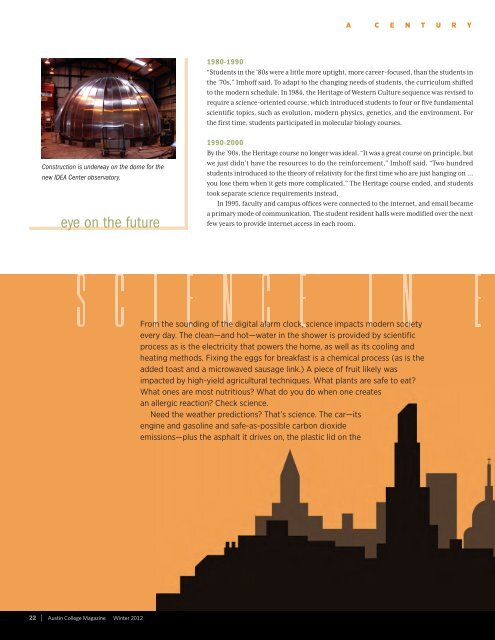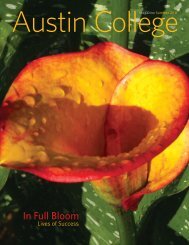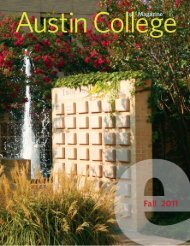Winter 2012 - Austin College Magazine
Winter 2012 - Austin College Magazine
Winter 2012 - Austin College Magazine
You also want an ePaper? Increase the reach of your titles
YUMPU automatically turns print PDFs into web optimized ePapers that Google loves.
A C E N T U R Y<br />
1980-1990<br />
“Students in the ’80s were a little more uptight, more career-focused, than the students in<br />
the ’70s,” Imhoff said. To adapt to the changing needs of students, the curriculum shifted<br />
to the modern schedule. In 1984, the Heritage of Western Culture sequence was revised to<br />
require a science-oriented course, which introduced students to four or five fundamental<br />
scientific topics, such as evolution, modern physics, genetics, and the environment. For<br />
the first time, students participated in molecular biology courses.<br />
Construction is underway on the dome for the<br />
new IDEA Center observatory.<br />
eye on the future<br />
1990-2000<br />
By the ’90s, the Heritage course no longer was ideal. “It was a great course on principle, but<br />
we just didn’t have the resources to do the reinforcement,” Imhoff said. “Two hundred<br />
students introduced to the theory of relativity for the first time who are just hanging on …<br />
you lose them when it gets more complicated.” The Heritage course ended, and students<br />
took separate science requirements instead.<br />
In 1995, faculty and campus offices were connected to the internet, and email became<br />
a primary mode of communication. The student resident halls were modified over the next<br />
few years to provide internet access in each room.<br />
From the sounding of the digital alarm clock, science impacts modern society<br />
every day. The clean—and hot—water in the shower is provided by scientific<br />
process as is the electricity that powers the home, as well as its cooling and<br />
heating methods. Fixing the eggs for breakfast is a chemical process (as is the<br />
added toast and a microwaved sausage link.) A piece of fruit likely was<br />
impacted by high-yield agricultural techniques. What plants are safe to eat?<br />
What ones are most nutritious? What do you do when one creates<br />
an allergic reaction? Check science.<br />
Need the weather predictions? That’s science. The car—its<br />
engine and gasoline and safe-as-possible carbon dioxide<br />
emissions—plus the asphalt it drives on, the plastic lid on the<br />
22 | <strong>Austin</strong> <strong>College</strong> <strong>Magazine</strong> <strong>Winter</strong> <strong>2012</strong>





